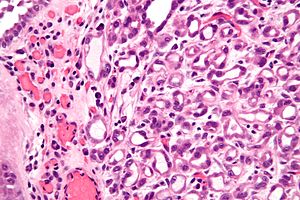Nephrogenic adenoma
Jump to navigation
Jump to search
Nephrogenic adenoma, also known as mesonephric adenoma,[1] and nephrogenic metaplasia, is a rare lesion that is classically in the urinary bladder and can mimic adenocarcinoma.
| Nephrogenic adenoma | |
|---|---|
| Diagnosis in short | |
 Nephrogenic adenoma. H&E stain. | |
|
| |
| LM | tubular structures with a microcystic appearance lined by hobnailed cells +/-thick eosinophilic basement membrane, usually associated with chronic inflammation |
| LM DDx | urothelial carcinoma microcystic and nested variants, prostatic adenocarcinoma, clear cell adenocarcinoma |
| IHC | CK7 +ve, PAX8 +ve, p53 -ve, CEA -ve, Ki-67 low (<5%) |
| Site | urothelium - usu. urinary bladder |
|
| |
| Prevalence | uncommon |
| Prognosis | benign |
It should not be confused with metanephric adenoma.
General
Features:[2]
- Benign.
- May mimic adenocarcinoma!
- Classic location is the urinary bladder.
- Also reported in ureter and prostatic urethra.
- It is thought to result from displacement of renal tubular cells, as this entity in renal transplant recipients is graft derived.[3]
Microscopic
Features:[2]
- Tubular structures - key feature.
- Hobnailed cells.
- +/-Thick eosinophilic basement membrane.
- Microcystic appearance.
- Usually associated with chronic inflammation.
Notes:
- May mimic vascular/lymphatic channels - can be sorted-out with IHC.
DDx:
- Urothelial carcinoma, microcystic and nested variants.
- Prostatic adenocarcinoma.
- Clear cell adenocarcinoma.
- Mesonephroid adenocarcinoma - very rare.[4][5]
Images
www:
IHC
Features:[7]
- CK7 +ve.
- PAX2 +ve.[8]
- PAX8 +ve.
- AMACR +ve/-ve.
Others:[2]
See also
References
- ↑ Singh, KJ. (Jan 2011). "Mesonephric adenoma in remnant ureteric stump: A rare entity.". Indian J Urol 27 (1): 140-1. doi:10.4103/0970-1591.78414. PMID 21716880.
- ↑ 2.0 2.1 2.2 Gokaslan, ST.; Krueger, JE.; Albores-Saavedra, J. (Jul 2002). "Symptomatic nephrogenic metaplasia of ureter: a morphologic and immunohistochemical study of four cases.". Mod Pathol 15 (7): 765-70. doi:10.1097/01.MP.0000019578.51568.24. PMID 12118115. http://www.nature.com/modpathol/journal/v15/n7/full/3880603a.html. Cite error: Invalid
<ref>tag; name "pmid12118115" defined multiple times with different content - ↑ Mazal, PR.; Schaufler, R.; Altenhuber-Müller, R.; Haitel, A.; Watschinger, B.; Kratzik, C.; Krupitza, G.; Regele, H. et al. (Aug 2002). "Derivation of nephrogenic adenomas from renal tubular cells in kidney-transplant recipients.". N Engl J Med 347 (9): 653-9. doi:10.1056/NEJMoa013413. PMID 12200552.
- ↑ Doddamani, D.; Ansari, MS.; Gupta, NP.; Aron, M.; Singh, I.; Datta Gupta, S. (2002). "Mesonephroid adenocarcinoma of the bladder and urethra: a case report.". Int Urogynecol J Pelvic Floor Dysfunct 13 (1): 47-9. PMID 11999207.
- ↑ Abbas, M.; Kramer, MW.; Wolters, M.; Herrman, TR.; Becker, JU.; Kreipe, HH. (Feb 2013). "Adenocarcinoma of the urinary bladder, mesonephroid type: a rare case.". Rare Tumors 5 (1): e3. doi:10.4081/rt.2013.e3. PMID 23772302.
- ↑ Kunju, LP. (Oct 2010). "Nephrogenic adenoma: report of a case and review of morphologic mimics.". Arch Pathol Lab Med 134 (10): 1455-9. doi:10.1043/2010-0226-CR.1. PMID 20923300.
- ↑ Alexiev, BA.; Levea, CM. (Mar 2012). "Nephrogenic Adenoma of the Urinary Tract: A Review.". Int J Surg Pathol. doi:10.1177/1066896912439095. PMID 22415059.
- ↑ Tong, GX.; Melamed, J.; Mansukhani, M.; Memeo, L.; Hernandez, O.; Deng, FM.; Chiriboga, L.; Waisman, J. (Mar 2006). "PAX2: a reliable marker for nephrogenic adenoma.". Mod Pathol 19 (3): 356-63. doi:10.1038/modpathol.3800535. PMID 16400326.
- ↑ Fromont, G.; Barcat, L.; Gaudin, J.; Irani, J. (Nov 2009). "Revisiting the immunophenotype of nephrogenic adenoma.". Am J Surg Pathol 33 (11): 1654-8. doi:10.1097/PAS.0b013e3181b40061. PMID 19730362.
- ↑ 10.0 10.1 Malpica, A.; Ro, JY.; Troncoso, P.; Ordoñez, NG.; Amin, MB.; Ayala, AG. (Apr 1994). "Nephrogenic adenoma of the prostatic urethra involving the prostate gland: a clinicopathologic and immunohistochemical study of eight cases.". Hum Pathol 25 (4): 390-5. PMID 7512941.